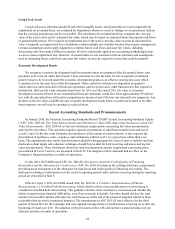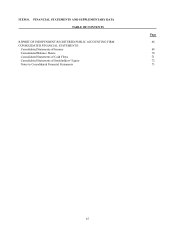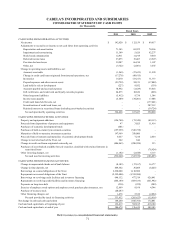Cabela's 2011 Annual Report Download - page 74
Download and view the complete annual report
Please find page 74 of the 2011 Cabela's annual report below. You can navigate through the pages in the report by either clicking on the pages listed below, or by using the keyword search tool below to find specific information within the annual report.64
Long-Lived Assets
Long-lived assets other than goodwill and other intangible assets, which generally are tested separately for
impairment on an annual basis, are evaluated for impairment whenever events or changes in circumstances indicate
that the carrying amount may not be recoverable. The calculation for an impairment loss compares the carrying
value of the asset to that asset’s estimated fair value, which may be based on estimated future discounted cash flows
or quoted market prices. We recognize an impairment loss if the asset’s carrying value exceeds its estimated fair
value. Frequently our impairment loss calculations contain multiple uncertainties because they require management
to make assumptions and to apply judgment to estimate future cash flows and asset fair values, including
forecasting cash flows under different scenarios. We have consistently applied our accounting methodologies that
we use to assess impairment loss. However, if actual results are not consistent with our estimates and assumptions
used in estimating future cash flows and asset fair values, we may be exposed to losses that could be material.
Economic Development Bonds
We recognize economic development bond investments based on estimates of the discounted future cash
payments to be received under these bonds. These estimates are also the basis for our recognition of deferred
grant revenue to be received under the economic development grants as an offset to construction costs which
is amortized over the asset lives of the development. These cash flow estimates are dependent on property
and/or sales tax collections derived from our operations, and in certain cases, other businesses in that respective
jurisdiction. Had our fair value estimates been lower by 10% as of the end of 2011, the value of economic
development bonds reflected in our consolidated financial statements would have been approximately $9 million
less with the unrealized loss reflected in comprehensive income (loss) if the loss was deemed to be temporary. Any
declines in the fair value available-for-sale economic development bonds below cost that are deemed to be other
than temporary are reflected in earnings as realized losses.
Recent Accounting Standards and Pronouncements
In January 2010, the Financial Accounting Standards Board (“FASB”) issued Accounting Standards Update
(“ASU”) No. 2010-06, Fair Value Measurements and Disclosures (Topic 820): Improving Disclosures about Fair
Value Measurements. ASU 2010-06 revises two disclosure requirements concerning fair value measurements
and clarifies two others. This statement requires separate presentation of significant transfers into and out of
Levels 1 and 2 of the fair value hierarchy and disclosure of the reasons for such transfers. It also requires the
presentation of purchases, sales, issuances, and settlements within Level 3 on a gross basis rather than a net
basis. The amendments also clarify that disclosures should be disaggregated by class of asset or liability and that
disclosures about inputs and valuation techniques should be provided for both recurring and non-recurring fair
value measurements. These disclosures about fair value measurements and the requirement concerning gross
presentation of Level 3 activity are presented in Note 25. The adoption of this statement had no effect on the
Company’s financial position or results of operations.
In July 2010, the FASB issued ASU No. 2010-20, Disclosures about the Credit Quality of Financing
Receivables and the Allowance for Credit Losses. ASU No. 2010-20 enhances the existing disclosure requirements
providing more transparency of the allowance for loan losses and credit quality of financing receivables. The
disclosures relating to information as of the end of a reporting period and to activity occurring during the reporting
period are presented in Note 5.
Effective April 5, 2011, the FASB issued ASU No. 2011-02, A Creditor’s Determination of Whether
Restructuring is a Troubled Debt Restructuring, which clarifies when a loan modification or restructuring is
considered a troubled debt restructuring. This guidance clarifies what constitutes a concession and whether the
debtor is experiencing financial difficulties, even if not currently in default. An entity should disclose the total
amount of receivables and the allowance for credit losses as of the end of the period of adoption related to those
receivables that are newly considered impaired. The amendments in ASU 2011-02 were effective for the third
quarter of fiscal 2011 for the Company, and were applied retrospectively to modifications occurring on or after the
beginning of fiscal year 2011. The adoption of the provisions of this ASU did not have a material impact on our
financial position or results of operations.
























